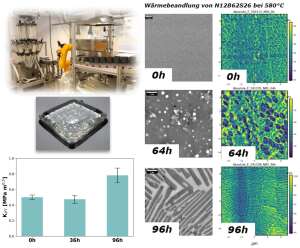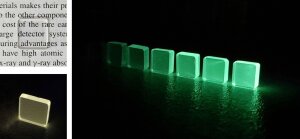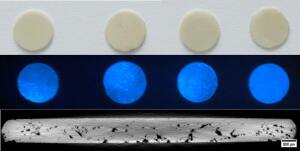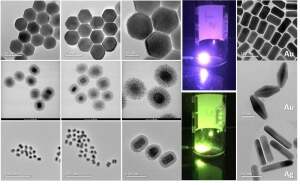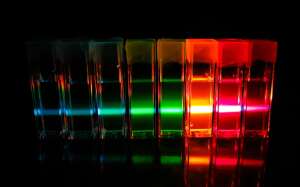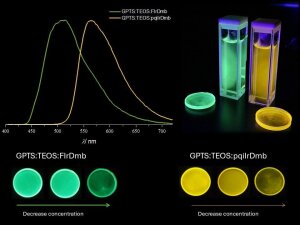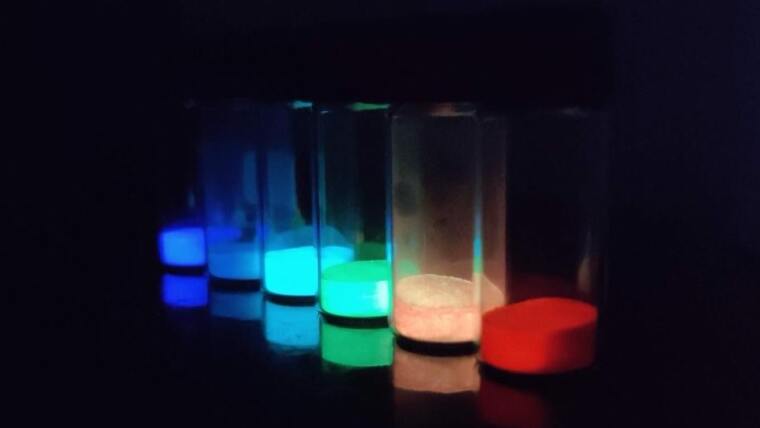
We study inorganic and hybrid materials with optical, mechanical, and biological functionalities. We seek structural-functional correlations by combining conventional and spectroscopic techniques.
-
Design of tough oxide glasses
Phase separation in B-silicate glasses
Image: Marco HolzerDespite their widespread application and importance, oxide glasses intrinsically suffer from low mechanical strength and there are many open questions regarding their structure, crack toughness and strength. To meet the demands of ever advancing applications by assuring materials robustness, such questions are addressed by us through a combination of multiscale modelling (DFT, MD) and experimental characterization (Raman, NMR, DCB, DMA, etc.). In the search for optimized compositions, we take advantage of the robotic glass melting plant at BAM and seek to establish structural relationships such as between internal friction and crack toughness, modelling fracture energy and dissipation during cracking. In borosilicate glasses, we have found a “zebra-like” phase separated microstructure that leads to an increase of glass toughness by up to 50%.
-
Optical glasses and glass ceramics
Scintillator glasses
Image: Thiago LodiIn optical glasses doped with emissive trivalent rare earth ions (RE), the chemical environmental has a direct influence on the radiative/non-radiative RE emission probabilities. The vibrational features and chemical nature of the bonds in the first coordination sphere can be tailored, to some extent, based on structural information given by spectroscopic techniques (NMR, EPR, Raman, FT-IR, UV-Vis and PLE). We are interested in developing RE-doped oxide and oxyfluoride glasses as scintillators, and for near and mid-IR applications. The doping can be associated with noble metal nanoparticles (NPs) and clusters, to explore plasmon enhancement and energy transfer. Currently, we also focus on improving the mechanical properties of these materials, as well as exploring glasses with semiconductor NPs.
-
Phosphor-in-glass (PiG) composites
PersL composites and X-ray tomography
Image: Marzieh Ghadamyari/Ranielle OliveiraWhen combined with appropriate glass hosts, luminescent powders or phosphors, with high quantum yield and/or persistent luminescence (PersL) that last minutes, or even hours, offer new perspectives for the development of composite materials with applications that range from solid state lighting to sensing. Different methods can be applied to combine the phosphor and glass powders such as direct addition to the melt, sintering (viscous flow, flashing) or via sol gel methodology. Crucial parameters are matching refractive index and particles sizes, powder dispersibility and stability/integrity during processing and in the long term. In this area, we have been exploring different approaches.
-
Upconversion Nanoparticles and Quantum Dots
UPCON (Left), and noble metal NPs (Right)
Image: Marylyn Arai/Valdinei LiberRare earth ion (RE) doped upconversion nanoparticles (UPCON) are extremely versatile nanomaterials with the ability to convert infrared excitation into UV and visible light. Upon excitation at 980 nm, the fluoride compositions NaYF4:RE (RE = Yb/Er or Yb/Tm), with hexagonal structure, are known to offer the most intense responses in the green and blue, respectively. The core particles can be coated with silica shells and further functionalized to bear on their surfaces specific biomolecules such as dyes, organometallic complexes, etc, through host-guest interactions. The combination of UPCON with noble metal NPs (Au, Ag), designed with specific shapes to tailor their plasmonic response, allow us the development of sensitive nanoplatforms for chemical, biological and environmental sensing.
-
Quantum Dots
CdTe quantum dots with different sizes
Image: Pedro CostaSemiconductor nanoparticles in the size range 1 - 10 nm (quantum dots), are resourceful luminescent nanomaterials with a range of applications, from solar concentrators to biological imaging and sensing. Due to their reduced dimensions, their bandgap energy is governed by size dependent quantum confinement, yielding tunable emissions over the whole visible spectrum. In our studies, we have implemented an in-situ growth monitoring approach to synthesize CdTe dots with controlled sizes by tracking their luminescence response. The dots have been investigated for oxygen detection, biolabeling, and for high order harmonic generation.
-
Sol-Gel based host guest hybrid materials
Hybrid materials based on Ir(III) complex
Image: Raquel VilelaSol gel is an extremely versatile soft chemistry methodology for the production of inorganic and hybrid organic-inorganic host-guest xerogel and glassy materials. It allows high homogeneity of precursors at the molecular level, mild synthesis conditions (temperature, pH), and flexible shaping (bulk, films, fibers, particles). Dense or mesoporous silicate and organosilicate hosts can be associated to guest molecules such as natural and synthetic dyes, organometallic complexes (Eu(III), Ir(II), Cu(I)), nanoparticles, and drugs, to produce functional materials. The association of these species have been done by us via covalent binding, van der Waals and Coulomb interactions, as well as through ship-in-a-bottle approach. Currently we are interested in combining bioactivity and luminescence for wound healing materials, as well as targeting energy related applications.
